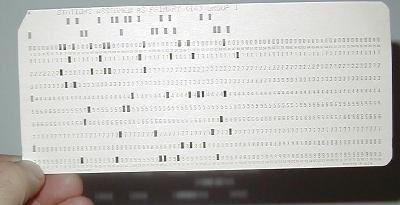
An early storage medium made of thin cardboard stock that holds data as patterns of punched holes.
Each of the 80 columns holds one character. The holes are punched by a keypunch machine or card punch peripheral and are fed into the computer by a card reader.
From 1890 until the 1970s, they were synonymous with data processing. Concepts were simple: the database was the file cabinet; a record was a card. Processing was performed on separate machines called sorters, collators, reproducers, calculators and accounting machines.
...
In the early days of mechanical and later electronic tabulation and analysis these cards contained the tabulation programs and raw data. They are 80 characters wide, severely limiting the amount of information that can be stored on a single card. Many shortcuts were employed to economize on the use of card space including the truncation of annual dates to the last two digits. As program and data storage moved from the card to magnetic tape and disks old habits died hard. In fact economy of instructions was a hallmark of good programming. And even if anyone thought of truncated dates as a potential problem, who would expect that programs written for computer systems in the 1970's and 1980's would still be in use in 1999.
Paper tape

A slow, low-capacity, sequential storage medium used in the first half
of the 20th century to hold data as patterns of punched holes. This was
one of the few media used to distribute software for PC's in the 70's.
![]()
pcbiography.net